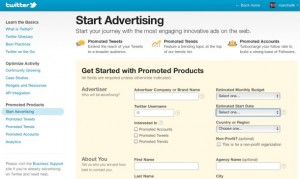Last month, when we were all starting to check out for the holidays, Twitter launched a new online form allowing users to purchase promoted tweets and trending topics. Up until that point, Twitter had been testing these avenues, but this development signified Twitter’s belief in this paid media option as a tangible business model. And then the rains came.
Actually, the feedback wasn’t all negative. In fact, the “Twitter is a business and eventually has to make money” contingent saw the move as a natural next step. And many began sharing examples of how promoted tweets and trends could be a cool way to drive visibility to a brand or topic during a specific event. But others weren’t so bullish on the news. Social Media Explorer’s Jason Falls had this to say:
“Selling trending topics is like gaming Digg (social bookmarking site). Twitter is inviting marketing money bags to completely ruin the organic nature of the tool. When I look at something like that, I tell clients, ‘They’re just whores for your money.’ It’s obvious they’re making Facebook-like errors to try and compensate for the fact they never had a business model in mind when they built this thing.”
Jason’s POV of view caught my eye, largely because I agree with him 100 percent. But when I posted on the SME Facebook page to tell him so, he told me he’d taken a lot of flack for that comment. My immediate reaction…Why?
His assessment is right on. Sure it’s a bit hyperbolic, but the essence of his words are true. Twitter is a conversation engine rooted in relationship building. It’s what makes the platform so valuable — the ability to meet new people, debate trending topics that are actually organic and not paid for, and most importantly, to build community. Hashtags and Twitter search have changed the way brands interact with consumers and the way people engage with each other.
The beauty of Twitter, what made it so popular, is the authenticity and access it facilitates. What’s sad is that I don’t think Twitter’s founders forgot that. I think they got lazy. You change the way people communicate, manage a new channel that goes beyond viral and the first few years are easy. Venture capital is pouring in along with the accolades. But as your product becomes mainstream and some of the newness wears off, people start asking, “What’s the long-term business model again?”
As Jason alluded to, I don’t think they had one. Easy for me to say, right? Sitting here without any of my money or life invested in Twitter. And I understand that. But falling back on the same old advertising model we’ve seen on the Internet for years? Couldn’t they have been more innovative and called on some of the foresight that led to predicting the value Twitter would have in the future when it launched in 2006? Advertising isn’t a useless tactic. But it’s effectiveness as a relationship builder has declined. It’s more of an exposure generator — and maybe it always was.
What if instead of selling ads — because that’s what promoted tweet and trends are, ads — Twitter sold conversation opportunities? For example:
- An official daily Twitter conversation at a set time on a set hashtag. The point of the event would be to introduce new people or brands to Twitter users and those who wished to be featured on a specific day’s conversation would pay a fee. It’s kind of like advertising, except that instead of paying for a one-way placement, the sponsorship would earn said company the opportunity to select the topic and engage with event attendees. That way Twitter would be teaching the “advertising” brands how to connect with customers via conversation.
- Twitter’s functionality has already led to the development of a plethora of online communities. What if Twitter partnered with those communities — e.g. the myriad of Twitter chats that take place each week — and helped match up sponsoring companies with the appropriate target communities. The brand gets to engage the chat participants and Twitter and the chat organizers each get a cut of the fee.
- Lastly, Twitter is all about building organic community. Or at least it always has been. Why doesn’t Twitter deep dive into a way to connect companies with communities that better fit their target customer market inside and outside of Twitter. The one complaint you do here about Twitter is that there’s so much there, so much noise, especially for companies just getting started. So don’t give a brand an easy way out by paying for tweets. Instead, facilitate the opportunity for them to connect with more niche groups, on or off of Twitter, or maybe via a combination. After all, most outside communities have a Twitter integration so the conversation can still live across platforms.
I’m not saying these ideas are right. Maybe they’d sink like a body thrown into the river by Tony Soprano. But I don’t understand why Twitter didn’t try to stick with what got it here — conversation. While promoted tweets and trends may be able to play an awareness roll in a strategic integrated marketing plan, the anchor component of any such strategy is listening and engagement. Twitter is moving forward with promoted tweets and trends to make ad dollars, not to benefit its users. We can’t fault them for that, they need to make money. But we can look at these new promoted options for what they are – advertisements in a conversation engine — and wonder why they “didn’t dance with the one that brought them.”






January 6, 2011
Integrated marketing communications, Marketing, Public relations, Social media, Twitter